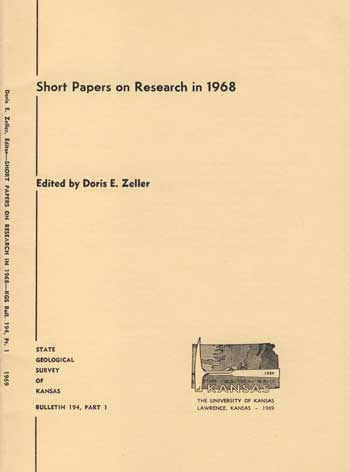
Kansas Geological Survey, Bulletin 194, pt. 1, originally published in 1969

Originally published in 1969 as part of "Short Papers on Research in 1968," Kansas Geological Survey Bulletin 194, part 1, p. 19-20. This is, in general, the original text as published. The information has not been updated.
Ceramic bodies with densities ranging from 14.5 to 28.8 lbs/cu ft and compressive strengths ranging from 84 to 232 psi were prepared from clay-expanded volcanic ash mixtures. Bodies were not watertight, but they can be used in nonload-bearing construction applications.
An interesting group of low-density clay-expanded volcanic ash bodies have been prepared (Tables 1 and 2). It was necessary to mix the materials in the following steps in order to prevent excessive crushing of the expanded ash and to create the proper cellular structure:
The addition of aluminum powder and sodium hydroxide is essential for the creation of good cellular structure. Hydrogen gas is released (Jacobson, 1946) according to the reaction
2NaOH+2Al+2H2O → 2NaAlO2+3H2.
Hydrogen gas forms small cells in the clay bonding matrix around the cellular ash, lowering the bulk density.
Table 1--Batch compositions for Champion and Challenger ball clay and expanded volcanic ash mixtures.
| Material | Volume, percent clay/ash | ||||
|---|---|---|---|---|---|
| 50/50 | 40/60 | 30/70 | 20/80 | 16/84 | |
| C & C ball clay* | 82.2*** | 77.8 | 71.5 | 61.6 | 56.8 |
| Expanded ash* | 10.6 | 15.1 | 21.5 | 31.8 | 36.7 |
| Wyoming bentonite | 2.4 | 2.3 | 2.2 | 1.8 | 1.6 |
| Hydrocal | 4.8 | 4.8 | 4.8 | 4.8 | 4.9 |
| Aluminum powder | ** | ** | ** | ** | ** |
| Water | 127 | 127 | 127 | 159 | 156 |
| 1 percent NaOH solution | 0.1 | 0.1 | 0.1 | 0.1 | 0.1 |
| * 0.1 cu ft expanded ash = 300 gms, 0.1 cu ft C & C ball clay = 2325 gms. ** 28 gms Al powder per cubic foot of dry material. *** Weight percent. |
|||||
Table 2--Batch compositions for C-27 (Cloud County, Kansas) clay and expanded volcanic ash mixtures (in weight percent).
| Material | Volume, percent clay/ash | ||
|---|---|---|---|
| 20/80 | 18/82 | 16/84 | |
| C-27 clay* | 66.8 | 64.6 | 62.6 |
| Expanded ash* | 26.2 | 28.5 | 30.6 |
| Wyoming bentonite | 2.2 | 2.1 | 2.0 |
| Hydrocal | 4.8 | 4.8 | 4.8 |
| Aluminum Powder | ** | ** | ** |
| Water | 167 | 176 | 182 |
| 1 percent NaOH solution |
0.1 | 0.1 | 0.1 |
| * 0.1 cu ft expanded ash = 300 gms, 0.1 cu ft C-27 clay = 3065 gms. ** 28 gms Al powder per cu ft of dry material. |
|||
Final shaping of the fired material can be done by any conventional method, cutting, sawing, drilling, chipping, gouging, etc., using ordinary steel tools. The surface can be colored either by the fusion of a glaze or application of an organic finish. Surface texture may be left in the rough condition or smoothed by the application of a filler material or engobe.
There is much variability in the strength versus bulk density relationship (Tables 3 and 4). The material is not capable of carrying a structural load but is capable of being used in any nonload-bearing application requiring a fire-resistant property. An interesting possible use is for sculpturing material. Its light weight is ideal for the creation of designs that need to be hung on a wall or suspended in the air.
Table 3--Physical properties of Champion and Challenger ball clay and expanded volcanic ash mixtures.
| Volume, percent clay/ash | |||||
|---|---|---|---|---|---|
| 50/50 | 40/60 | 30/70 | 20/80 | 16/84 | |
| Percent water absorption | 105 | 135 | 138 | 222 | 207 |
| Crushing strength, psi | 113 | 137 | 232 | 107 | 86 |
| Bulk density, lbs/cu ft | 28.8 | 22.6 | 26.0 | 15.2 | 15.9 |
Table 4--Physical properties of C-27 (Cloud County, Kansas) clay and expanded volcanic ash mixtures.
| Volume, percent clay/ash | |||
|---|---|---|---|
| 20/80 | 18/82 | 16/84 | |
| Percent water absorption | 177 | 200 | 214 |
| Crushing strength, psi | 145 | 135 | 184 |
| Bulk density, lbs/cu ft | 17.4 | 16.1 | 14.5 |
C. A. Jacobson, 1946, Encyclopedia of chemical reactions: Reinhold Pub. Corp., N.Y., v. 1, p. 48.
Kansas Geological Survey, Short Papers on Research in 1968
Placed on web July 26, 2011; originally published in Feb. 1969.
Comments to webadmin@kgs.ku.edu
The URL for this page is http://www.kgs.ku.edu/Publications/Bulletins/194_1F/index.html